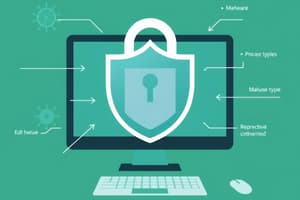Podcast
Questions and Answers
What is the primary objective of ransomware?
What is the primary objective of ransomware?
- To steal personal information from a victim's computer.
- To disrupt the normal operation of a victim's computer.
- To encrypt a victim's files and demand payment for decryption. (correct)
- To spread itself to other computers without the user's knowledge.
Which of the following security measures is MOST effective against ransomware?
Which of the following security measures is MOST effective against ransomware?
- Employing two-factor authentication.
- Using strong passwords.
- Avoiding suspicious links and attachments in emails.
- Regularly updating system software and security programs. (correct)
How do cookies potentially threaten user privacy?
How do cookies potentially threaten user privacy?
- They can track a user's online activity and create a detailed profile of their interests. (correct)
- They can be used to steal passwords and other sensitive information from a user's computer.
- They can spread viruses and malware to a user's computer.
- They can overload a user's computer with unwanted data.
What is a key difference between scareware and a hoax?
What is a key difference between scareware and a hoax?
Which of the following is NOT a benefit of using two-factor authentication?
Which of the following is NOT a benefit of using two-factor authentication?
What is the primary objective of cybersecurity?
What is the primary objective of cybersecurity?
Which type of hacker is known for breaking into systems for illegal gain?
Which type of hacker is known for breaking into systems for illegal gain?
What is the main purpose of phishing attacks?
What is the main purpose of phishing attacks?
Which of the following is a recommended practice for personal cybersecurity?
Which of the following is a recommended practice for personal cybersecurity?
What does a keylogger primarily do?
What does a keylogger primarily do?
Which of the following is not considered a form of malware?
Which of the following is not considered a form of malware?
What is a key aspect of organizational security best practices?
What is a key aspect of organizational security best practices?
What is the function of an Intrusion Detection System (IDS)?
What is the function of an Intrusion Detection System (IDS)?
What is the primary goal of ransomware attacks?
What is the primary goal of ransomware attacks?
Which of the following is NOT a form of malware?
Which of the following is NOT a form of malware?
What does the term 'social engineering' refer to in cybersecurity?
What does the term 'social engineering' refer to in cybersecurity?
What type of attack involves intercepting and altering communication between two parties?
What type of attack involves intercepting and altering communication between two parties?
Which of the following is a potential impact of cybercrime?
Which of the following is a potential impact of cybercrime?
What does a phishing attack typically involve?
What does a phishing attack typically involve?
Which of the following describes a Zero-Day exploit?
Which of the following describes a Zero-Day exploit?
What is a common method used to secure against malware?
What is a common method used to secure against malware?
Flashcards
Virus
Virus
A program that attaches itself to another program and spreads itself to other computers.
Ransomware
Ransomware
Malware that encrypts a victim's files and demands payment for the decryption key.
Cookies
Cookies
Small text files that websites use to assign an ID number to your computer.
Scareware
Scareware
Signup and view all the flashcards
Hoax
Hoax
Signup and view all the flashcards
Cybersecurity
Cybersecurity
Signup and view all the flashcards
Keylogger
Keylogger
Signup and view all the flashcards
Packet Analyzer (Sniffer)
Packet Analyzer (Sniffer)
Signup and view all the flashcards
Virtual Private Network (VPN)
Virtual Private Network (VPN)
Signup and view all the flashcards
Two-Factor Authentication (2FA)
Two-Factor Authentication (2FA)
Signup and view all the flashcards
Firewall
Firewall
Signup and view all the flashcards
Antivirus Software
Antivirus Software
Signup and view all the flashcards
Malware
Malware
Signup and view all the flashcards
Phishing
Phishing
Signup and view all the flashcards
Denial-of-Service (DoS) Attack
Denial-of-Service (DoS) Attack
Signup and view all the flashcards
Man-in-the-Middle (MitM) Attack
Man-in-the-Middle (MitM) Attack
Signup and view all the flashcards
SQL Injection
SQL Injection
Signup and view all the flashcards
Zero-Day Exploit
Zero-Day Exploit
Signup and view all the flashcards
Social Engineering
Social Engineering
Signup and view all the flashcards
Study Notes
Cybersecurity Fundamentals
- Cybersecurity is the act of protecting systems, networks, and data from digital attacks, theft, and damage. Cybersecurity involves information security, network security, and application security.
- Cybersecurity protects computers, servers, mobile devices, electronic systems, and data from malicious attacks.
- Cybersecurity encompasses protecting systems, networks, and data from digital attacks. It also covers information, network, and application security.
- A hacker is anyone who unlawfully breaks into a computer system.
Types of Hackers
- White hat hackers are ethical hackers who test system vulnerabilities.
- Black hat hackers use malicious methods to break into systems for illegal gain
- Gray hat hackers break into systems to demonstrate their expertise.
Packet Analyzer (Sniffer)
- A packet analyzer is a program used by hackers.
- It examines each data packet as it travels over the internet looking for sensitive data.
Common Cybersecurity Threats
- Malware: This includes viruses, worms, Trojans, and spyware, designed to harm or exploit systems.
- Phishing: Attackers impersonate trusted entities to steal sensitive information. Techniques include deceptive emails and fake websites.
- Ransomware: Malware that encrypts a victim's files and demands payment for decryption. It is often distributed via phishing and downloads.
- Denial-of-Service (DoS) Attacks: Overload systems with traffic, disrupting services.
- Man-in-the-Middle (MitM) Attacks: Attackers intercept and alter communications between parties without their knowledge.
- SQL Injection: Exploits vulnerabilities in web applications to execute malicious code.
- Zero-Day Exploits: Target previously unknown vulnerabilities in software.
- Social Engineering: Manipulating individuals into divulging sensitive information or performing actions that compromise security. This has a detrimental impact on finances, reputation, and may lead to legal action.
Personal Security Best Practices
- Strong Passwords: Use complex, unique passwords for each account, combining letters, numbers, and symbols.
- Two-Factor Authentication (2FA): Implement an additional verification layer beyond passwords.
- Regular Software Updates: Keep systems updated to patch vulnerabilities.
- Secure Connections: Utilize secure connections (SSL/TLS) for online activities.
- Phishing Awareness: Be cautious of unsolicited emails and messages.
Organizational Security Best Practices
- Comprehensive Security Policies: Establish clear guidelines for security.
- Employee Training: Educate staff about security threats and best practices.
- Access Controls: Restrict access to sensitive data and systems appropriately.
- Incident Response Planning: Have a plan in place to address security incidents.
- Regular Security Audits: Regularly assess and strengthen security measures.
- Data Encryption: Protect sensitive data in transit and storage.
- Patch Management: Keep software up-to-date with the latest security patches.
- Network Security: Secure network infrastructure.
Cybersecurity Tools
- Antivirus/Anti-Malware
- Firewalls
- Intrusion Detection Systems
- Encryption Tools
- Patch Management Systems
- Security Information Management
- Virtual Private Networks (VPNs)
- Multi-Factor Authentication Solutions
Current Cybersecurity Trends
- AI-Powered Attacks
- IoT Vulnerabilities
- Supply Chain Attacks
- Ransomware as a Service
- Zero Trust Architecture
- Cloud Security Improvements
- Quantum Computing Preparedness
- Expanding Regulatory Compliance
Cybercrime Types
- Scam: Fraudulent schemes to trick people out of money.
- Identity Theft: Stealing personal information.
- Non-Delivery of Merchandise: Unsuccessful purchase attempts.
- Advance-Fee Fraud: Schemes promising large rewards in exchange for a fee.
- Hacking: Unauthorized access to computer systems or networks.
- Blackmail: Using threats or coercion to gain something.
Malware
- Malicious software designed to disrupt, damage, gain unauthorized access. Malware examples include viruses, worms, Trojans, ransomware, spyware, and adware.
Phishing
- A cyber-attack where attackers pose as trustworthy entities to steal information.
Virus
- A program that replicates itself on other computers by attaching itself to another program (host program).
- This often leaves a trace or is embedded within the host code.
Ransomware
- Malware that encrypts a victim's files and demands payment for decryption.
- Ransomware frequently employs phishing techniques, downloads, and exploits.
SPAM & SPIM
- Spam: Unwanted emails.
- SPIM: Unsolicited instant messages
Cookies
- Small text files websites store on a user's computer to track their activity on the website.
Scareware & Hoaxes
- Scareware: Malware intended to convince victims of a problem and to pay money to fix it.
- Hoaxes: Attempts to deceive someone into believing something false.
Strong Passwords
- Use complex and unique passwords for different accounts that contain a blend of letters, numbers, and symbols.
Key Takeaways
- Cybersecurity is everyone's responsibility
- Continuous learning and adaptation are crucial.
- Proactive security measures are more effective than reactive measures.
Studying That Suits You
Use AI to generate personalized quizzes and flashcards to suit your learning preferences.




